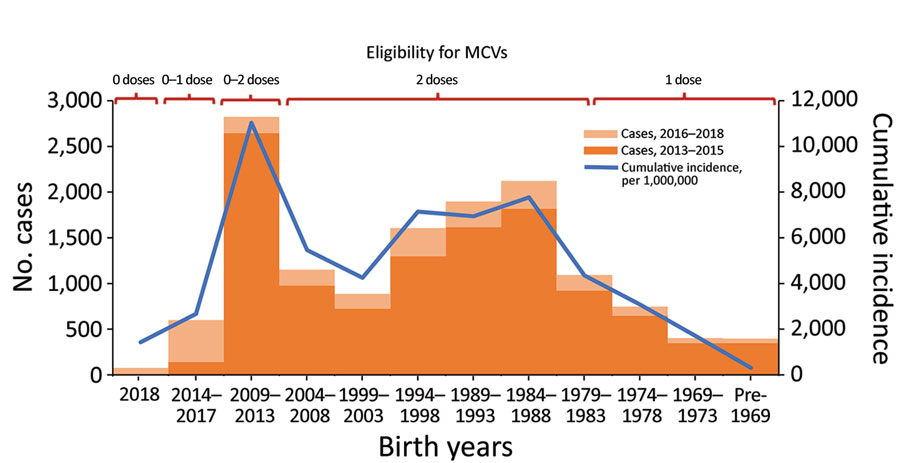Challenges to Achieving Measles Elimination, Georgia, 2013–2018
Nino Khetsuriani

, Ketevan Sanadze, Rusudan Chlikadze, Nazibrola Chitadze, Tamar Dolakidze, Tamta Komakhidze, Lia Jabidze, Shahin Huseynov, Myriam Ben Mamou, Claude Muller, Khatuna Zakhashvili, and Judith M. Hübschen
Author affiliations: Centers for Disease Control and Prevention, Atlanta, Georgia, USA (N. Khetsuriani); CDC South Caucasus Office, Tbilisi, Georgia (N. Khetsuriani); National Center for Disease Control and Public Health, Tbilisi (K. Sanadze, R. Chlikadze, N. Chitadze, T. Dolakidze, T. Komakhidze, L. Jabidze, K. Zakhashvili); South Caucasus Field Epidemiology and Laboratory Training Program, Tbilisi (T. Komakhidze); World Health Organization European Regional Office, Copenhagen, Denmark (S. Huseynov, M. Ben Mamou); World Health Organization European Regional Reference Laboratory for Measles and Rubella, Luxembourg Institute of Health, Esch-sur-Alzette, Luxembourg (C. Muller, J.M. Hübschen)
Main Article
Figure 4

Figure 4. Reported measles cases during 2013–2015 and 2016–2018 and cumulative incidence (cases/1 million population) for 2013–2018, by birth year and eligibility to MCVs, Georgia. Children born during 2014–2017 gradually became eligible for the first dose of measles-mumps-rubella vaccine (MMR) by 2018 as the respective birth cohorts turned 1 year old. Children born during 2009–2013 were <5 years of age in 2013, at the start of 2013–2015 outbreak, and were either too young to be vaccinated (2013 cohort) or were eligible for the first dose of MMR vaccine only (2009–2012 cohorts), but gradually became eligible for the second dose of MMR vaccine by 2018, as the respective birth cohorts turned 5 years old. The 1981–2008 birth cohorts were eligible to 2 doses of MCV (measles vaccine, measles-rubella vaccine or MMR) through routine program, several supplementary immunization activities, or both. The 1959–1980 cohorts were eligible for 1 dose of measles vaccine through routine vaccination or catch-up immunizations conducted at the time of vaccine introduction. MCV, measles-containing vaccine.
Main Article
Page created: September 14, 2020
Page updated: October 17, 2020
Page reviewed: October 17, 2020
The conclusions, findings, and opinions expressed by authors contributing to this journal do not necessarily reflect the official position of the U.S. Department of Health and Human Services, the Public Health Service, the Centers for Disease Control and Prevention, or the authors' affiliated institutions. Use of trade names is for identification only and does not imply endorsement by any of the groups named above.
